
Haymarket Theatre
Londres - Angleterre
Construction: 1821
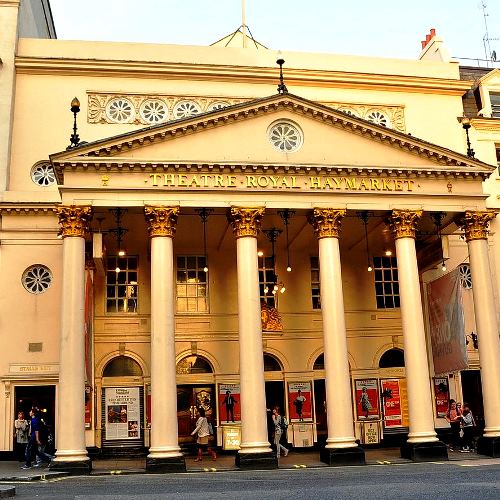
Topologie du théâtre
Nombre de salles actives: 1
Salle 1: (890) 1821 - Actif
Accès
En métro: Piccadilly Circus
En bus:
Adresse: 8 Haymarket, Westminster, London, SW1Y 4HT
Evolution
Bâtiment: 1720. John Potter builds his theatre on the site of the King’s Head Inn / 1821. The Theatre Royal designed by John Nash opens / 1843. Alterations to stage and auditorium / 1879. Architect C. J. Phipps remodels the auditorium / 1904. Complete rebuilding of auditorium, preserving front of house and backstage, by architect Charles Stanley Peach.
Nom:
Propriétaire(s)
Remarquable
Historically and architecturally one of the most significant theatres in Britain.

890
1821 - Actif
Standing under the canopy of Her Majesty’s Theatre to look across the Haymarket, it Is extremely difficult to compose a picture In one’s mind’s eye of the Immediate area in 1513, when John Norris willed to his wife, Christian, his croft along with an enclosed three-acre toft. Picturesque it probably was not, close to an area where the expanding City of London would meet a developing City of Westminster; but this was the field upon which the Theatre Royal would eventually be built. In 1575 the land was occupied by the widow Golightly, and in 1610 the Earl of Northampton was building stables on it. Around 1614 the Earl of Suffolk bought the stables along with nearby Northampton House and changed their name. By the end of the 17th century Suffolk Street and its environs were laid out, and handsome, ‘well-inhabited’ houses began to appear.
In 1720 John Potter, a local carpenter, built the New French Theatre on the site of the King’s Head, an inn fronting the Haymarket, and a gun shop in Suffolk Street to its rear, demolishing both to make way for the playhouse. Situated In the northwest angle of John Norris’s toft, It lay to the north of the modern theatre, and it was not until about 1730 that it became known as The Little Theatre In the Haymarket. Officially closed in 1737 under the Licensing Act of George II, the theatre managed by various Ingenious, not to say nefarious, means to keep going. In 1767, a royal patent was granted permitting the house to ‘exhibit plays’ between May and September in an enlarged and improved building renamed the Theatre Royal - thus breaking the grip on the theatrical profession held by Drury Lane and Covent Garden, the only two other playhouses licensed by royal patent. Eventually, however, with the manager George Colman failing to run the theatre efficiently from prison, where he was in residence for debt, the building was closed around 1818-19, and lost in subsequent conversion works around 1819-20.
The decline and demise of the theatre may to some extent be accounted for by the general dilapidation of its surroundings, and It was reborn when architect John Nash produced a regeneration scheme aimed at revitalizing Suffolk Street and Its immediate neighbourhood in the early 1820s. Talented architects such as J. P. Gandy-Deering, one of three eminent architect brothers, and William Wilkins, who designed the National Gallery in 1834, built here - all under the strict design control of Nash, who himself provided a number of houses, Including No. 6 Suffolk Street, the Gallery of the Royal Society of British Artists (restored in 1979).
As part of his grand plan Nash encouraged the rebuilding of the theatre as a focal point on the axis of Charles II Street, and to this end he proposed a deep, giant pedimented, six-columned Corinthian portico with five arched doorways giving access to the pit, boxes, galleries and box office. This configuration echoed the flat-roofed four-columned portico of the earlier building. Above the proposed portico, a sheer attic wall pierced only by a recessed panel of nine radial glazed oculi would be provided. Like the front, the Suffolk Street elevation is stuccoed and distinctly domestic in character. Internally the auditorium was almost square, with two levels of boxes extending around three sides and enclosing the pit. Access corridors ran behind the boxes from an entrance lobby.
The theatre reopened on 4 July 1821 under the management of David Morris, George Colman’s brother-in-law, with a production of Richard Brinsley Sheridan's The Rivals. In 1843 ‘extensive alterations' were made when the stage was pushed back to allow the introduction of orchestra stalls, and pit seats were abolished to be replaced by the more expensive stalls.
Squire Bancroft, who had managed the Scala in Charlotte Street from 1871, took over at the Haymarket In 1879, immediately initiating a rebuilding programme and commissioning architect C. J. Phipps to remodel the Interior, modernizing it and bringing it up to date with a picture-frame proscenium and a reseated auditorium. Decorative plasterwork was executed by George Jackson and Sons, a firm that retained in its workshops until the late 20th century a wonderful collection of 18th- century moulds.
Herbert Beerbohm Tree, one of the last great actor-managers, ran the theatre from 1888 until he moved to Her Majesty's in 1896. In October that same year Frederick Harrison and Cyril Maude, who moved to the Playhouse In 1907, took over and in 1904 set out to modernize yet again, engaging architects Charles Stanley Peach and S. D. Adshead to carry out the work - an odd choice, as Peach’s reputation was built on electricity generating stations and his design for the Centre Court buildings at Wimbledon. The work was confined in the main to the auditorium, where a modem structural frame replaced the perhaps less stable existing fabric. The result Is a stunning essay In elegant Louis XVI decoration, surpassed nowhere in London.
In a deep cellar behind the proscenium arch, 19th-century timber stage machinery still survives today; three bridges remain in situ with original sliders, a rarity indeed. Between 1915 and 1939 a three-piece sliding stage was Installed using
boat trucks. Regrettably, the thunder run was removed in 1970 to accommodate a new counterweight system.
A plaque on the back of the building records that the first performances of Oscar Wilde's A Woman of No Importance (1893) and An Ideal Husband (1895) took place here.
Historically of tremendous importance, this theatre has been the subject of books and lectures on all of its aspects; and doubtless one day, when the fabric becomes unsteady through age, the archaeologists will have their say, too.
1720. John Potter builds his theatre on the site of the King’s Head Inn / 1821. The Theatre Royal designed by John Nash opens / 1843. Alterations to stage and auditorium / 1879. Architect C. J. Phipps remodels the auditorium / 1904. Complete rebuilding of auditorium, preserving front of house and backstage, by architect Charles Stanley Peach.
Historically and architecturally one of the most significant theatres in Britain.

Musical
Original
1) Only Fools and Horses (Original)
Joué durant 1 an 2 mois
Première preview: sam. 09 février 2019
Première: mar. 19 février 2019
Dernière: Open end
Compositeur: Jim Sullivan • Paul Whitehouse •
Parolier: Jim Sullivan • Paul Whitehouse •
Libettiste:
Metteur en scène: Caroline Jay Ranger •
Chorégraphe:
Avec: Tom Bennett, Ryan Hutton, Andy Mace, Dianne Pilkington, Pippa Duffy, Jeff Nicholson, Samantha Seager, Peter Baker, Pete Gallagher, Adrian Irvine, Adam Venus, Chris Kiely, Oscar Conlon-Morrey, Melanie Marshall, Chris Bennett, Lee Van Geleen, Lisa Bridge, Philip Childs, Andrew Bryant, Samantha Lane, Bradley John
Commentaire:
Presse: In The Times, Dominic Maxwell wrote: 'Do we need an Only Fools and Horses musical? Frankly, these days we could do with all the fun we can get. Which is why it's such a shame that this effort by Paul Whitehouse and Jim Sullivan — son of the great sitcom's creator and writer, John Sullivan — is such an odd mix of the tried-and-tested and the new-and-half-cocked. It's got lovely moments. It's got moments you wouldn't buy off the back of a three-wheeled van.'
Mark Lawson in the Guardian said: 'The finest collection of vintage gags on the London stage should allow the show to make a fair amount of what Del Boy calls 'lovely jubbly'. But, as a musical, a few too many of the songs are, to borrow again from the Trotter lingo, plonkers.'
And Dominic Cavendish in the Daily Telegraph wrote: 'Only generous-hearted fools and die-hard fans need apply within for this endearing but theatrically under-achieved stage-musical version of the much-loved BBC sitcom.'
However, Rachael Bletchly was more positive in the Daily Mirror, writing: 'Del's still got the sheepskin but still 'hasn't got a pot to p*** in', Grandad's back in his armchair, suffering with his Chalfonts, and Rodders is still punching above his weight romancing classy Cassandra, played by Pippa Duffy.
'But now they're all singing and dancing too, truly making this joyous nostalgic romp down Hooky Street the creme de la menthe. No wonder tickets are as rare as a genuine Rolex in Del's suitcase.'
Alun Hood wrote in WhatsOnStage: 'It's not a well-crafted musical in the traditional sense but then you'd expect a stage life of the Peckham Trotters to be a bit rough-round-the-edges. It has heart, wit and warmth by the bucketload.'
And Mark Shenton for London Theatre said: 'Just how much you warm to it will largely depend on your wish to revisit a beloved TV series in this new but hardly revelatory format.
'As directed and choreographed by Caroline Jay Ranger, the pace is uneven; songs fail to emerge organically out of the action, but feel bolted onto a version of a TV script.'
Plus d'infos sur cette production:
Plus d'infos sur ce musical

Musical
Revival
37) Heathers The Musical (Revival)
Joué durant 2 mois 2 semaines
Première preview: 21 June 2021
Première: 28 June 2021
Dernière: 11 September 2021
Compositeur: Kevin Murphy • Laurence O'Keefe •
Parolier: Kevin Murphy • Laurence O'Keefe •
Libettiste: Kevin Murphy • Laurence O'Keefe •
Metteur en scène: Andy Fickman •
Chorégraphe: Gary Lloyd •
Avec: Christina Bennington (Veronica Sawyer), Jordan Luke Gage (Jason Dean - JD), Jodie Steele (Heather Chandler), Bobbie Little (Heather Duke), Frances Mayli McCann (Heather McNamara), Lauren Ward (Fleming/Veronica's Mother), Madison Swan (Martha), Simon Bailey (Ram's Dad/Big Bud Dean/Coach), Joaquin Pedro Valdes (Ram Sweeney), Steven Serlin (Kurt's Dad/Veronica's Dad/Principle Gowan)
Commentaire: Following a London premiere at The Other Palace and a subsequent West End transfer in 2018, Heathers is back at Theatre Royal Haymarket. (plus)
Presse:
Plus d'infos sur cette production:
Plus d'infos sur ce musical

Musical
Original London
36) Band (The) (Original London)
Joué durant 1 mois 1 semaine
Première preview: 01 December 2018
Première: 05 December 2018
Dernière: 12 January 2019
Compositeur:
Parolier:
Libettiste: Tim Firth •
Metteur en scène: Kim Gavin • Jack Ryder •
Chorégraphe:
Avec:
Commentaire:
Presse:
Plus d'infos sur cette production:
Plus d'infos sur ce musical

Musical
West End Transfer
35) Heathers The Musical (West End Transfer)
Joué durant 2 mois 2 semaines
Première preview: 03 September 2018
Première: 11 September 2018
Dernière: 24 November 2018
Compositeur: Kevin Murphy • Laurence O'Keefe •
Parolier: Kevin Murphy • Laurence O'Keefe •
Libettiste: Kevin Murphy • Laurence O'Keefe •
Metteur en scène: Andy Fickman •
Chorégraphe:
Avec: Carrie Hope Fletcher (Veronica Sawyer), Jodie Steele (Chandler), T’Shan Williams (Duke) and Sophie Isaacs (McNamara), alongside Jamie Muscato as rebellious transfer student Jason Dean (JD), Chris Chung (Kurt Kelly), Dominic Anderson (Ram Sweeney), Jenny O’Leary (Martha Dunnstock), Rebecca Lock (Ms. Flemming), Jon Boydon (Kurt’s Dad), Alex James Hatton (Officer Milner), Charlotte Jaconelli (Stoner Chick), Lauren Drew (New Wave Girl), Olivia Moore (Young Rerepublicanette), and Sergio Pasquariello (Officer McCord), Hugh Maynard (Ram’s Dad), John Lumsen (Hipster Dork) and Merryl Ansah (Drama Cub Drama Queen)
Commentaire: Following a number of workshop performances and then a full production at The Other Palace, Laurence O'Keefe and Kevin Murphy musical adaptation of Heathers is set to transfer to West End. It will run at the Theatre Royal Haymarket from 3rd September to 24th November starring West End sensation Carrie Hope Fletcher. (plus)
Presse:
Plus d'infos sur cette production:
Plus d'infos sur ce musical

Théâtre
Original
34) Tartuffe (Original)
Joué durant 2 mois
Première preview: 25 May 2018
Première: 29 May 2018
Dernière: 28 July 2018
Compositeur:
Parolier:
Libettiste: Molière •
Metteur en scène: Gerald Garutti •
Chorégraphe:
Avec: Paul Anderson (Tarfuffe), Audrey Fleurot (Elmire).
Commentaire: Adaptation de Christopher Hampton.
L.A. Present day. French media tycoon Orgon has re-located to Tinseltown with his family, his heart set on becoming Hollywood royalty. With a new studio to his name, and a palatial Beverly Hills mansion, his empire seems infallible. But all is not as it seems as Orgon falls under the seductive spell of Tartuffe, a radical American evangelist. So comprehensively has Tartuffe hoodwinked Orgon that he looks set to steal his fortune, drive away his son, seduce his wife and marry his daughter.
This thrilling new adaptation of Molière’s classic comedy, penned by Academy, BAFTA and Olivier award winner Christopher Hampton (ART, Dangerous Liaisons, Atonement), and directed by the former dramaturg of the French People’s National Theatre Gerald Garutti, will premiere as the West End’s first ever dual language theatre production, alternating between English and French with surtitles throughout. (plus)
Presse:
Plus d'infos sur cette production:
Plus d'infos sur ce musical

Théâtre
33) Oncle Vania ()
Joué durant
Première preview: 15 May 2018
Première: 15 May 2018
Dernière: 17 May 2018
Compositeur:
Parolier:
Libettiste: Anton Chekhov •
Metteur en scène:
Chorégraphe:
Avec:
Commentaire: Performed in Russian with English surtitles. (plus)
Presse:
Plus d'infos sur cette production:
Plus d'infos sur ce musical

Théâtre
32) Life and Fate ()
Joué durant 1 semaine
Première preview: 08 May 2018
Première: 08 May 2018
Dernière: 20 May 2018
Compositeur: *** Divers •
Parolier: *** Divers •
Libettiste: *** Divers •
Metteur en scène: Lev Dodin •
Chorégraphe:
Avec:
Commentaire: This critically acclaimed production, winner of the Golden Mask for best play, has toured around the world to great acclaim since 2007 and comes to London for the first time. Performed in Russian with English surtitles. (plus)
Presse:
Plus d'infos sur cette production:

Théâtre
Revival
31) Frozen (Revival)
Joué durant 2 mois 1 semaine
Première preview: 09 February 2018
Première: 21 February 2018
Dernière: 05 May 2018
Compositeur: *** Divers •
Parolier: *** Divers •
Libettiste: *** Divers •
Metteur en scène: Jonathan Munby •
Chorégraphe:
Avec: Suranne Jones, Jason Watkins
Commentaire: The play premiered at the Birmingha Repetory Theatre in 1998, and was revived at the National Theatre’s Cottesloe Theatre in 2002, and also received a run on Broadway in 2004, when it was nominated for the Tony Award for Best Play. (plus)
Presse:
Plus d'infos sur cette production:

Musical
Revival
30) Rat Pack (The) (Revival)
Joué durant 1 mois 3 semaines
Première preview: 13 December 2017
Première: 13 December 2017
Dernière: 03 February 2018
Compositeur:
Parolier:
Libettiste:
Metteur en scène:
Chorégraphe:
Avec:
Commentaire: 13/12 > 6/1 : Christmas With The Rat Pack
9/1 > 3/2: The Rat Pack - Live from Las Vegas (plus)
Presse:
Plus d'infos sur cette production:
Plus d'infos sur ce musical

Théâtre
Original London
29) Venus In Fur (Original London)
Joué durant 1 mois 3 semaines
Première preview: 06 October 2017
Première: 17 October 2017
Dernière: 09 December 2017
Compositeur: *** Divers •
Parolier: *** Divers •
Libettiste: *** Divers •
Metteur en scène: Patrick Marber •
Chorégraphe:
Avec:
Commentaire:
Presse:
Plus d'infos sur cette production:

Théâtre
West End Transfer
28) Queen Anne (West End Transfer)
Joué durant 2 mois 3 semaines
Première preview: 30 June 2017
Première: 10 July 2017
Dernière: 30 September 2017
Compositeur: *** Divers •
Parolier: *** Divers •
Libettiste: *** Divers •
Metteur en scène: Natalie Abrahami •
Chorégraphe:
Avec: Romola Garai (Sarah, Duchess of Marlborough) Emma Cunniffe (Queen Anne)
Commentaire: Following a critically acclaimed, sold-out season at the Swan Theatre in Stratford-upon-Avon, the Royal Shakespeare Company production of Queen Anne transfers to the Theatre Royal Haymarket from 30 June. (plus)
Presse:
Plus d'infos sur cette production:

Théâtre
Revival
27) The Goat, Or Who is Sylvia? (Revival)
Joué durant 2 mois 2 semaines
Première preview: 24 March 2017
Première: 05 April 2017
Dernière: 24 June 2017
Compositeur: *** Divers •
Parolier: *** Divers •
Libettiste: *** Divers •
Metteur en scène: Ian Rickson •
Chorégraphe:
Avec: Damian Lewis
Commentaire: The original London production played at the Almeida Theatre in 2004 and was nominated for 3 Olivier Awards including Best New Play. Jonathan Pryce starred as Martin Gray, with Kate Fahy as Stevie and Eddie Redmayne as Billy. (plus)
Presse:
Plus d'infos sur cette production:

Théâtre
Revival
26) Love's Labour's Lost (Revival)
Joué durant 3 mois
Première preview: 17 December 2016
Première: 17 December 2016
Dernière: 18 March 2017
Compositeur:
Parolier:
Libettiste: William Shakespeare •
Metteur en scène: Christopher Luscombe •
Chorégraphe: Jenny Arnold •
Avec: Sam Alexander (King of Navarre/Don John), John Arthur (Sir Nathaniel/Antonio), William Belchambers (Longaville/Conrade), Edward Bennett (Berowne/Benedick), Paige Carter (Maria/Ursula), Rebecca Collingwood (Katharine/Hero), Lisa Dillon (Rosaline/Beatrice), Nick Harris (Butler/Francis Pickbone/Butler/Officer/Musician), Nick Haverson (Costard/Dogberry), John Hodgkinson (Don Armado/Don Pedro), Tunji Kasim (Dumaine/Claudio), Emma Manton (Jaquenetta/Margaret), Chris McCalphy (Dull/Sexton), Peter McGovern (Moth/George Seacole/Soldier), Chris Nayak (Footman 1/Borachio), Jamie Newall (Boyet/Friar Francis), Steven Pacey (Holofernes/Leonato), Roderick Smith (Gatekeeper 1/Marcade/Verges), Jamie Tyler (Footman/Hugh Oatcake), Harry Waller (Gamekeeper 2/Marcade/Balthasar), Anna Wheatley (Housemaid/Housemaid), Leah Whitaker (Princess of France).
Commentaire: Following a 2014 run in Stratford-upon-Avon and a subsequent in Chichester, the RSC Chichester Festival Theatre productions of the heart-warming double bill Love’s Labour’s Lost and Much Ado About Nothing (or Love's Labour's Won) will transfer to the Theatre Royal Haymarket for a limited season. (plus)
Presse:
Plus d'infos sur cette production:
Plus d'infos sur ce musical

Théâtre
Revival
25) Much ado about nothing (Revival)
Joué durant 3 mois
Première preview: 09 December 2016
Première: 17 December 2016
Dernière: 18 March 2017
Compositeur:
Parolier:
Libettiste: William Shakespeare •
Metteur en scène: Christopher Luscombe •
Chorégraphe: Jenny Arnold •
Avec: Sam Alexander (King of Navarre/Don John), John Arthur (Sir Nathaniel/Antonio), William Belchambers (Longaville/Conrade), Edward Bennett (Berowne/Benedick), Paige Carter (Maria/Ursula), Rebecca Collingwood (Katharine/Hero), Lisa Dillon (Rosaline/Beatrice), Nick Harris (Butler/Francis Pickbone/Butler/Officer/Musician), Nick Haverson (Costard/Dogberry), John Hodgkinson (Don Armado/Don Pedro), Tunji Kasim (Dumaine/Claudio), Emma Manton (Jaquenetta/Margaret), Chris McCalphy (Dull/Sexton), Peter McGovern (Moth/George Seacole/Soldier), Chris Nayak (Footman 1/Borachio), Jamie Newall (Boyet/Friar Francis), Steven Pacey (Holofernes/Leonato), Roderick Smith (Gatekeeper 1/Marcade/Verges), Jamie Tyler (Footman/Hugh Oatcake), Harry Waller (Gamekeeper 2/Marcade/Balthasar), Anna Wheatley (Housemaid/Housemaid), Leah Whitaker (Princess of France).
Commentaire: Following a 2014 run in Stratford-upon-Avon and a subsequent in Chichester, the RSC Chichester Festival Theatre productions of the heart-warming double bill Love’s Labour’s Lost and Much Ado About Nothing (or Love's Labour's Won) will transfer to the Theatre Royal Haymarket for a limited season. (plus)
Presse:
Plus d'infos sur cette production:
Plus d'infos sur ce musical

Théâtre
24) Libertine (The) ()
Joué durant 2 mois 1 semaine
Première preview: 22 September 2016
Première: 27 September 2016
Dernière: 03 December 2016
Compositeur: *** Divers •
Parolier: *** Divers •
Libettiste: *** Divers •
Metteur en scène: Terry Johnson •
Chorégraphe:
Avec: Dominic Cooper (Earl of Rochester), Jasper Britton (King Charles II), Mark Hadfield (Etherege) and Ophelia Lovibond (Elizabeth Barry). Further cast include Alice Bailey Johnson, Will Barton, Cornelius Booth, Will Merrick, Lizzie Roper, Richard Teverson, Nina Toussaint-White, Emily Byrt, Jonathan Hansler, Joseph Macnab, James Marchant and Lydia Piechowiak.
Commentaire:
Presse: "Not a full-on flop all told but be warned, if you go seeking after the elixir of lusty excitement you may end up feeling you’ve but quaffed a cup of Earl Grey." Dominic Cavendish for The Telegraph
"The play may be too lewd for prudes, but it offers an invigorating, warts-and-all portrait of a self-destructive sceptic." Michael Billington for The Guardian
Plus d'infos sur cette production:

Théâtre
23) Breakfast at Tiffany's ()
Joué durant 2 mois 2 semaines
Première preview: 30 June 2016
Première: 30 June 2016
Dernière: 17 September 2016
Compositeur: *** Divers •
Parolier: *** Divers •
Libettiste: *** Divers •
Metteur en scène: Nikolai Foster •
Chorégraphe:
Avec: Pixie Lott (Holly Golightly), Matt Barber (Fred), Victor McGuire (Joe Bell), Robert Calvert (Doc), Naomi Cranston (Mag), Charlie De Melo (José), Tim Frances (Rusty Trawler/Editor at 21), Andrew Joshi(Yunioshi), Melanie La Barrie (Mme Spanella), Sevan Stephan (OJ Berman/Dr Goldman), Katy Allen and Andy Watkins
Commentaire: Arrêt à Londres d'un UK Tour (plus)
Presse:
Plus d'infos sur cette production:

Théâtre
Revival
22) How the other half loves (Revival)
Joué durant 2 mois 3 semaines
Première preview: 23 March 2016
Première: 31 March 2016
Dernière: 25 June 2016
Compositeur: *** Divers •
Parolier: *** Divers •
Libettiste: *** Divers •
Metteur en scène: Julie Godfrey •
Chorégraphe:
Avec: Nicholas Le Prevost, Jenny Seagrove, Jason Merrells, Tamzin Outhwaite, Matthew Cottle and Gillian Wright
Commentaire:
Presse:
Plus d'infos sur cette production:

Théâtre
Revival
21) Bad JewsBad Jews (Revival)
Joué durant 1 mois 1 semaine
Première preview: 08 February 2016
Première: 08 February 2016
Dernière: 19 March 2016
Compositeur: *** Divers •
Parolier: *** Divers •
Libettiste: *** Divers •
Metteur en scène: Michael Longhurst •
Chorégraphe:
Avec: Ilan Goodman (Liam), Ailsa Joy (Daphna), Antonia Kinlay (Melody) and Jos Slovick (Jonah)
Commentaire:
Presse:
Plus d'infos sur cette production:

Théâtre
Original
20) McQueen (Original)
Joué durant 1 mois 3 semaines
Première preview: 22 August 2015
Première: 27 August 2015
Dernière: 17 October 2015
Compositeur: *** Divers •
Parolier: *** Divers •
Libettiste: *** Divers •
Metteur en scène: John Caird •
Chorégraphe:
Avec: Stephen Wight (Lee Alexander McQueen), Carly Bawden (Dahlia), Tracy-Ann Oberman (Isabella Blow), Laura Rees (Arabella), Michael Bertenshaw (Mr Hitchcock)
Commentaire: Au départ, en preview depuis le 13 août 2015, la première preview a été reportée au 22 août 2015. Le spectacle a eu une fermeture anticipée le 17 octobre au lieu du 7 novembre 2015. (plus)
Presse:
Plus d'infos sur cette production:

Théâtre
Revival
19) Elephant Man (The) (Revival)
Joué durant 2 mois 1 semaine
Première preview: 19 May 2015
Première: 01 June 2015
Dernière: 08 August 2015
Compositeur: *** Divers •
Parolier: *** Divers •
Libettiste: *** Divers •
Metteur en scène: Scott Ellis •
Chorégraphe:
Avec: Bradley Cooper (John Merrick), Patricia Clarkson (Mrs. Kendal), Alessandro Nivola (Dr. Frederick Treves), Anthony Heald (Ross / Bishop How), Scott Lowell (Snork / Pinhead Manager / Lord John), Kathryn Meisle (Miss Sandwich / Princess), Henry Stram (Carr Gomm / Conductor), Chris Bannow, Peter Bradbury, Lucas Calhoun, Eric Clem, Amanda Lea Mason, Marguerite Stimpson, Emma Thorne
Commentaire:
Presse: "Much as I admire Cooper’s performance, I still find Pomerance’s play – as I did on its Hampstead theatre premiere in London in 1977 – thin and tendentious." Michael Billington for The Guardian
"Cooper is touching and unshowy in the title role and, together with co-star Alessandro Nivola, completely carries Scott Ellis’s sluggishly directed production. " Ben Lawrence for The Telegraph
"The part demands remarkable focus — which he achieves. What could be a flashy exercise instead feels rigorously controlled. But even as he rises to the physical and vocal challenges, he can’t obscure the creakiness of the material with which he’s working." Henry Hitchings for The Evening Standard
Plus d'infos sur cette production:
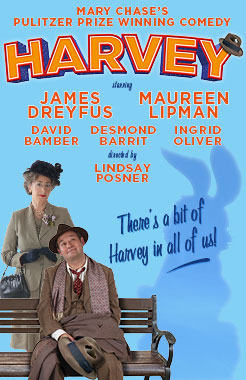
Théâtre
Revival
18) Harvey (Revival)
Joué durant 1 mois 1 semaine
Première preview: 17 March 2015
Première: 23 March 2015
Dernière: 02 May 2015
Compositeur: *** Divers •
Parolier: *** Divers •
Libettiste: *** Divers •
Metteur en scène: Lindsay Posner •
Chorégraphe:
Avec: James Dreyfus (Elwood P. Dowd), Maureen Lipman (Veta Louise Simmons), David Bamber (William R. Chumley), Desmond Barrit (Judge Omar Gaffney), Felicity Dean (Betty Chumley), Ingrid Oliver (Myrtle Mae Simmons), Amanda Boxer (Miss Ethel Chauvenet), Sally Scott (Nurse Ruth Kelly), Youssef Kerkour (Duane Wilson), Jack Hawkins (Lyman Sanderson) and Linal Haft (E J Lofgren)
Commentaire:
Presse: "It creaks in places but this gentle show has gorgeous sets and a slow-burn charm. Rational science is undone by gooey illusion? Atheist Richard Dawkins would not approve. I quite enjoyed it." Quentin Letts for The Daily Mail
"Lipman’s customary spot-on comic timing saves more than one moribund scene – look out for some cherishable business with a dishevelled wig - and there’s a lovely supporting turn, imbued with the sort of emotional honesty that is too often lacking elsewhere, from Sally Scott as a sharp-witted nurse frustrated by her condescending male superiors." Fiona Mountford for The Evening Standard
Plus d'infos sur cette production:

Théâtre
West End Transfer
17) Taken at Midnight (West End Transfer)
Joué durant 1 mois 2 semaines
Première preview: 15 January 2015
Première: 26 January 2015
Dernière: 14 March 2015
Compositeur: *** Divers •
Parolier: *** Divers •
Libettiste: *** Divers •
Metteur en scène: Jonathan Church •
Chorégraphe:
Avec: Penelope Wilton (Irmgard), Martin Hutson (Hans Litten), Allan Corduner (Franz Litten), Pip Donaghy (Erich Muhsam), Mike Grady (Carl von Ossietzky), John Light (Dr Conrad), David Yelland (Lord Clifford Allen), Marc Antolin (Gustav Hammerman), Christopher Hogben (Hotelier), Dermont McLaughlin (SA Officer)
Commentaire: Transfert à londres de la production du Chichester Festival (plus)
Presse: "Much sensitivity and skill have been brought to bear on Jonathan Church’s production, all of which makes one wish that the play itself were less pro forma than it is. Time and again, there is the sense that the actual events must have been infinitely more disturbing, and the gathering portentousness of the writing has the perverse effect of closing off the experience, instead of enlarging a playgoer’s empathic response." Matt Wolf for The New York Times
"a superb performance by Penelope Wilton as Irmgard. Wilton increasingly reminds me of the great Peggy Ashcroft in her ability to convey moral authority without any ostentatious display of acting technique..."
Michael Billington for The Guardian (Review of the Chichester production)
"Penelope Wilton achieves a perfect mix of passion and authority in this affecting portrait of a woman resisting the tyranny of the Nazis. Her performance vibrates with indignation, yet is skilfully measured — it’s a study of heartbreak, but also of grace." Henry Hitchings for The Evening Standard
Plus d'infos sur cette production:

Théâtre
West End Transfer
16) Great Britain (West End Transfer)
Joué durant 3 mois 2 semaines
Première preview: 10 September 2014
Première: 26 September 2014
Dernière: 10 January 2015
Compositeur: *** Divers •
Parolier: *** Divers •
Libettiste: *** Divers •
Metteur en scène: Nicholas Hytner •
Chorégraphe:
Avec: Lucy Punch (Paige Britain), Sarah Annis, Ross Boatman, Robert Calvert, William Chubb, Dermot Crowley, Jo Dockery, Robert Glenister, Ian Hallard, James Harkness, Scott Karim, Barbara Kirby, Nicholas Lumley, Ben Mansfield, Maggie McCarthy, Iain Mitchell, Miles Mitchell, Aaron Neil, Nick Sampson, Kellie Shirley, Kiruna Stamell, Harriet Thorpe, Rupert Vansittart, Joseph Wilkins, Andrew Woodall.
Commentaire: West End transfer de la pièce créée au National Theatre (Lyttelton theatre) en juin 2014 (plus)
Presse: "You’ll laugh, you’ll be appalled and you’ll have a memorable evening out - perhaps a little discomfort is a small price to pay." Paul Gent for The Telegraph
"Nicholas Hytner’s production bounds along like the class clown, sticking two fingers — and often one — up at a range of targets." Fiona Mountford for The Evening Standard
Plus d'infos sur cette production:

Théâtre
15) Daytona ()
Joué durant 1 mois 2 semaines
Première preview: 30 June 2014
Première: 07 July 2014
Dernière: 23 August 2014
Compositeur: *** Divers •
Parolier: *** Divers •
Libettiste: *** Divers •
Metteur en scène: David Grindley •
Chorégraphe:
Avec: Maureen Lipman (Elli), Harry Shearer (Joe) and Oliver Cotton (Billy)
Commentaire:
Presse: "What begins as a play about the killing of a Nazi winds up as a deeply moving love story in old age, and in the final scene it transcends words as Lipman and Shearer perform a captivating quickstep together, with only Billy as their audience." Charles Spencer for The Daily Telegraph
"There's real potential in the premise; it's because of authorial clumsiness in the way the idea is handled that the play comes over as hollow and unearned." Paul Taylor for The Independent
"Daytona is overstuffed, and a lack of focus means it never drives home any of the points it seems interested in making." Henry Hitchings for The Evening Standard
Plus d'infos sur cette production:
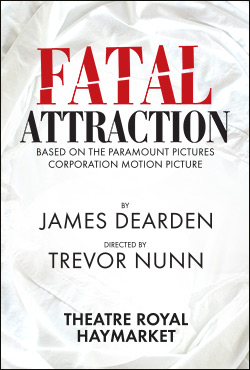
Théâtre
Original
14) Fatal Attraction (Original)
Joué durant 2 mois 3 semaines
Première preview: 08 March 2014
Première: 25 March 2014
Dernière: 21 June 2014
Compositeur: *** Divers •
Parolier: *** Divers •
Libettiste: *** Divers •
Metteur en scène: Trevor Nunn •
Chorégraphe:
Avec:
Commentaire:
Presse:
Plus d'infos sur cette production:

Théâtre
Revival
13) One Man, Two Guvnors (Revival)
Joué durant 1 an 12 mois
Première preview: 02 March 2012
Première: 02 March 2012
Dernière: 01 March 2014
Compositeur:
Parolier:
Libettiste:
Metteur en scène: Nicholas Hytner •
Chorégraphe: Adam Penford •
Avec: Owain Arthur (Francis Henshall), Angela Griffin (Dolly), Kellie Shirley (Pauline Clench), Peter Caulfield (Alfie), Dominic Thorburn (Alan Dangle), Sam Alexander (Stanley Stubbers), David Benson (Gareth), Ian Burfield (Charlie Clench), Amy Cudden (Rachel Crabbe), Derek Elroy (Lloyd), Hugh Sachs (Harry Dangle).
Commentaire:
Presse: "An evening of riotous delight"
Charles Spencer for The Daily Telegraph
"Bubbles over with humour. A surefire hit. "
Henry Hitchings for The Evening Standard
"One massive hit"
Paul Taylor for The Independent
"One of the funniest productions in the National's history."
Michael Billington for The Guardian
Plus d'infos sur cette production:
Plus d'infos sur ce musical

Théâtre
Revival
12) Flare Path (Revival)
Joué durant 3 mois
Première preview: 04 March 2011
Première: 10 March 2011
Dernière: 11 June 2011
Compositeur: *** Divers •
Parolier: *** Divers •
Libettiste: *** Divers •
Metteur en scène: Trevor Nunn •
Chorégraphe:
Avec: Sienna Miller (Patricia), James Purefoy (Peter), Sheridan Smith (Doris) , Joe Armstrong (Dusty), Sarah Crowden (Mrs.Oakes), Clive Woods (Swanson), Jim Creighton (Wiggy Jones), Mark Dexter (Count Skriczevinsky), Harry Hadden-Paton (Teddy), Emma Handy (Maudie), Matthew Tennyson (Percy)
Commentaire:
Presse: "Magnificent revival...overwhelmingly moving."
Michael Billington for The Guardian
"Richly entertaining and beautifully judged revival of this theatrical rarity."
Paul Taylor for The Independent
"Superb production as a three-handkerchief weepie that somehow manages to be both profoundly moving and wonderfully funny."
Charles Spencer for The Daily Telegraph
"...tempted to nod off in parts...the pace limps along like a battle-battered Wellington bomber flying on one engine."
Paul Callan for The Daily Express
"Sir Trevor's direction is lucid and scrupulously precise...polished and potent."
Henry Hitchings for The Evening Standard
Plus d'infos sur cette production:

Musical
Revival
11) Sweet Charity (Revival)
Joué durant 6 mois
Première preview: 23 April 2010
Première: 04 May 2010
Dernière: 06 November 2010
Compositeur: Cy Coleman •
Parolier: Dorothy Fields •
Libettiste: Neil Simon •
Metteur en scène: Matthew White •
Chorégraphe: Stephen Mear •
Avec: Tamzin Outhwaite (Charity), Mark Umbers (Oscar/Vittorio/Charlie), Josefina Gabrielle (Nicky/Ursula), Tiffany Graves (Helene), Paul J. Medford (Brubeck), Annalisa Rossi, Jayde Westaby, Rachael Archer, Ebony Molina, Jack Edwards, Zak Nemorin
Commentaire: This was yet another in the sequence of scaled-down musicals at the Menier Chocolate Factory which received excellent notices and would go on to future life in the West End itself. The show was notable for the excellent performance by Tamzin Outhwaite (best known for playing Mel in “Eastenders”). It was also the first to have the same actor, Mark Umbers, play all three of Charity’s love interests. The show transferred to the Theatre Royal Haymarket on May 4 th (previews from April 23 rd ) and ran for six months, closing on November 6 th. (plus)
Presse: "The music is consistently as atmospheric and tuneful as Stephen Mear’s choreography, though much indebted to the great Bob Fosse, is crisp and lively....It is fun, fun fun. . " The Times
"The show itself is a joy. From the moments you hear the bleary, brassy opening notes of the show’s most famous number, Hey Big Spender, one knows — as the song promises — that one is in for a good time. The band handles Cy Coleman’s outstanding jazzy score with superb panache throughout. The cast do splendid justice to Dorothy Fields’s witty and often touching lyrics and Neil Simon’s gag-filled script, in which he largely avoids the mushy sentimentality that is so often his downfall. " Charles Spencer for The Daily Telegraph
"Comes up trumps . " Mark Shenton for The Stage
"This is an ingratiating, exuberant show with some gorgeous balletic moments and a winning vitality. " Henry Hitchings for The Evening Standard
Plus d'infos sur cette production:
Plus d'infos sur ce musical
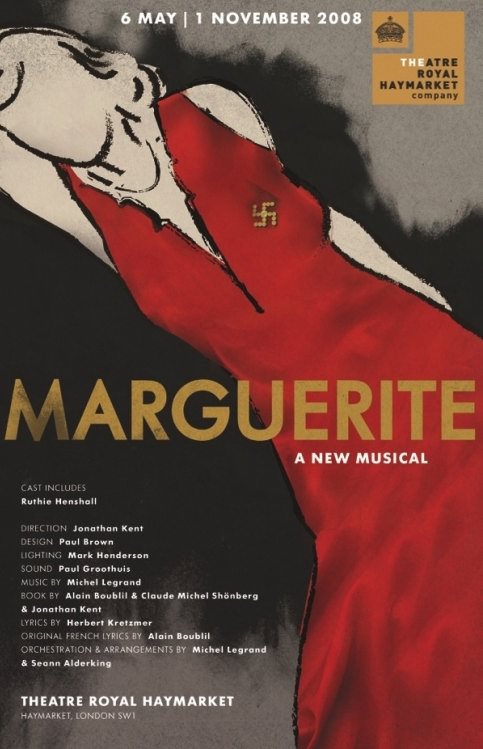
Musical
Original
10) Marguerite (Original)
Joué durant 3 mois 3 semaines
Première preview: 07 May 2008
Première: 20 May 2008
Dernière: 13 September 2008
Compositeur: Michel Legrand •
Parolier: Alain Boublil • Herbert Kretzmer •
Libettiste: Alain Boublil • Claude-Michel Schonberg •
Metteur en scène: Jonathan Kent •
Chorégraphe: Aucun •
Avec: Ruthie Henshall (Marguerite), Julian Ovenden (Armand), Matt Cross (Pierrot), Alexander Hanson (Otto), Simon Thomas (Lucien), Annalene Beechey (Annette), Andrew C. Wadsworth (Georges), Gay Soper (Chanteuse), Keiron Crook (Hermann)
Commentaire: This was an updated version of the Dumas novel “La Dame aux Camélias” and was received very favourably by the critics, with special praise for Ruthie Henshall. However, it was a dark tale and failed to catch on with the public. Originally scheduled to run until the beginning of November, lack of business led to its early closing on September 13 th . Since then it has undergone major re-writing and the new version has been staged in Japan and in the Czech Republic (plus)
Presse: NICHOLAS DE JONGH for THE EVENING STANDARD says, "Engaging production...The musical, both its book and music, did not greatly captivate me, but I was impressed by the way it raises serious moral questions. "
CHARLES SPENCER for THE DAILY TELEGRAPH says, "It's a serious disappointment...There's no real tension in the writing, while the characterisation is flaccid in the extreme."
BENEDICT NIGHTINGALE for THE TIMES says, " Decent, enjoyable but not exactly thrilling show."
PAUL TAYLOR for THE INDEPENDENT says, "Fluent, strikingly designed production...a compelling, if flawed, new work."
MICHAEL BILLINGTON for THE GUARDIAN says, "If you can accept a musical with a less-than-sympathetic heroine, then there are things to savour...Fast-moving production."
Plus d'infos sur cette production:
Plus d'infos sur ce musical

Musical
Revival
9) Seven Brides for Seven Brothers (Revival)
Joué durant 3 mois
Nb de représentations: 109 représentations
Première preview: 10 August 2006
Première: 16 August 2006
Dernière: 18 November 2006
Compositeur: Al Kasha • Gene de Paul • Joel Hirschhorn •
Parolier: Al Kasha • Joel Hirschhorn • Johnny Mercer •
Libettiste: David Landay • Lawrence Kasha •
Metteur en scène: Maurice Lane •
Chorégraphe: Adrian Allsopp •
Avec: Dave Willetts (Adam), Shona Lindsay (Milly), David Ball, Jonathan Stewart, Sonny Lee Hymas, Owen Woodgate, Stuart Marshall, Jay Webb, Claire Louise Connolly, Jessica Punch, Nikki Stokes, Grace Harrington, Lucy Johnson, Natalie Langston
Commentaire: This production came into the West End following a UK tour, and received a very mixed reaction from the critics. It was accused of having a wobbly set, acting pitched at pantomime level, and very slow direction. On the other hand the choreography was praised for its energy and the cast for their enthusiasm. It ran for just over three months. (plus)
Presse: CHARLES SPENCER for THE DAILY TELEGRAPH says, "The best one can say of the dancing is that the company perform with spirited energy. Unfortunately, Adrian Allsop's choreography, though virile and athletic, has none of the inventive wit of Michael Kidd's original routines, while the fight sequences are downright pathetic...woefully drab and unimaginative production" KIERON QUIRKE for THE EVENING STANDARD says, "Devitalised revival...Dave Willetts' Adam and Shona Lindsay's Milly show teeth and sing well but there's zilch chemistry there." BENEDICT NIGHTINGALE for THE TIMES says, "It’s good-natured, boasts the jaunty and pretty score that won an Oscar. At the Haymarket it offers plenty of energetic, athletic ballet...The acting...has an over-the-top swagger about it." ALISTAIR SMITH for THE STAGE says, "The acting is fine, the choreography energetic but the production values are really not up to the required standards." MICHAEL BILLINGTON for THE GUARDIAN says, "The show rarely rises above an honest competence. Dave Willetts as Adam looks suitably gruff and surly, but the character is an unlikeable stiff."
Plus d'infos sur cette production:
Plus d'infos sur ce musical

Concert
Concert
8) Genius of Ray Charles (The) (Concert)
Joué durant 1 mois 3 semaines
Première preview: 16 June 2005
Première: 20 June 2005
Dernière: 13 August 2005
Compositeur: *** Divers •
Parolier: *** Divers •
Libettiste: *** Divers •
Metteur en scène:
Chorégraphe:
Avec:
Commentaire: With a cast of 9 singers and 12 dancers, orchestra of 16 musicians and a medley of 36 songs associated with Ray Charles, this was a tribute compilation staged just a year after his death. It was billed as “a new musical created by David King”. The critics hated it - claiming false pretences, since it was nothing more than a concert, and claimed the loudest sound of the evening was that of Ray Charles spinning in his grave. (plus)
Presse: CHARLES SPENCER for THE DAILY TELEGRAPH says, "This lamentable jukebox musical comes as a horrid shock....The six leading singers, three women and three men, all sing tunefully enough, and the 14-piece (worryingly white) band know the notes, though they give little impression of emotional involvement in the music."
JACK MASSARIK for THE EVENING STANDARD says, "This slick song-and-dance extravaganza makes no attempt to explain how a blind Georgia orphan could claw his way from abject poverty to the very top of the showbiz mountain. There's no book here, not a single line of dialogue. Nothing, indeed, but songs in glorious profusion."
CLIVE DAVIS for THE TIMES says, "Seasoned fans of the great man’s music won’t get an awful lot out of the juke-box presentation, but then the show is not really designed for them. People who know only two or three of the hits, on the other hand, will get a crash course in one of the pioneers of American music....Given that the West End has been awash with anonymous tribute shows, I hesitate to welcome another into town. But there is at least a spark to this one."
LISA MARTLAND for THE STAGE says, "This disappointing compilation show...only hints at the great musician’s style, versatility and inspiration."
JOHN L WATERS for THE GUARDIAN says, "The second act wisely ends with the big hits but what the show lacks - if you'll forgive the metaphor - is vision."
SARAH HEMMING for THE FINANCIAL TIMES says, "There is something relentless and empty about the show. It is so over-amplified that it assaults you with the music, rather than coaxing you."
Plus d'infos sur cette production:
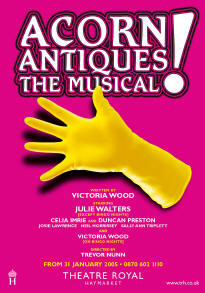
Musical
Original
7) Acorn Antiques (Original)
Joué durant 3 mois 1 semaine
Première preview: 27 January 2005
Première: 10 February 2005
Dernière: 21 May 2005
Compositeur: Victoria Wood •
Parolier: Victoria Wood •
Libettiste: Victoria Wood •
Metteur en scène: Trevor Nunn •
Chorégraphe: Stephen Mear •
Avec: Victoria Wood (Monday evenings and Wednesday matinees only), Julie Walters (Mrs Overall) (Tuesday to Saturday evenings and Saturday matinees only), Celia Imrie (Miss Babs), Duncan Preston (Mr Clifford), Neil Morrisey (John), Josie Lawrence & Sally Ann Triplett (Mrs Berta)
Commentaire: A ten minute sketch inside a 30 minute TV comedy series had been expanded into a three hour musical. As a result, the first half and second halves were virtually two different shows. The whole thing was a muddle, but with its hugely talented cast, and its satire ranging from “Crossroads” to “Les Mis” and Starbucks to Sondheim, and with Victoria Wood and Julie Walters alternating in the lead role, it attracted an audience of fanatical supporters who roared with delight at every familiar gag and malfunctioning prop. In 2006 the show was completely re-written for a major UK tour, so that the entire show was now the “straight” musical performance of “Acorn Antiques”. Mrs Overall was played by Ria Jones and the tour received excellent notices and was felt to be much better for the changes. It is this revised version which is now regarded as the “real” show. (plus)
Presse: NICHOLAS DE JONGH for THE EVENING STANDARD says, "A musical farce and a farsical musical...No Memorable numbers "
MICHAEL BILLINGTON for THE GUARDIAN says, "A load of slack, self-indulgent rubbish."
PAUL TAYLOR for THE INDEPENDENT says, "I haven't laughed as helplessly since the day I heard Bernadette had closed at the Dominion. It's the supreme cheek of the endeavour that will irritate some people and exhilarate the rest of us."
BENEDICT NIGHTINGALE for THE TIMES says, "Mischievous, good-natured, charming. But a comic masterpiece? Not really."
Plus d'infos sur cette production:
Plus d'infos sur ce musical

Musical
Original
6) Hard Times (Original)
Joué durant 2 mois 3 semaines
Nb de représentations: 95 représentations
Première preview: 22 May 2000
Première: 06 June 2000
Dernière: 26 August 2000
Compositeur: Chris Tookey • Hugh Thomas •
Parolier: Chris Tookey • Hugh Thomas •
Libettiste:
Metteur en scène: Chris Tookey •
Chorégraphe: Craig Revel Horwood •
Avec: Brian Blessed (Dickens/Gradgrind), Roy Hudd (Samuel Sleary), Ann Emery (Mrs Sleary/Mrs Gradgrind), Helen Anker (Louisa), Malcolm Rennie (Bounderby), Peter Blake (Harthouse), Susan-Jane Tanner, Matt Rawle, Ray C. Davis
Commentaire: The circus-format derived from the appearance in the novel of Samuel Sleary’s travelling circus, but the whole jolly format came over as a send-up of the novel, rather than a musical. The musical style ranged from Gilbert & Sullivan to romantic ballads and vaudeville numbers and the show itself was amiable, silly and old fashioned. With Brian Blessed (“never knowingly underplayed”) and Roy Hudd in an extension of his glorious music-hall acts, this was a curious mish-mash, and came off on August 26th after just three months. (plus)
Presse: THE TIMES says, "A warm, thoroughly likeable evening, but not one that fulfils Dickens's more serious aims.."
THE GUARDIAN says, "This tuppence-coloured tuner reminds us of the days when the musical was a source of innocent delight."
THE FINANCIAL TIMES says, "Once it gets going, it is amiable and rather charming, and it has a warmth about it that is very welcome after some of the more soulless blockbuster musicals. "
THE DAILY TELEGRAPH critic says " I particularly relished the moment when Mrs Gradgrind got up and performed an energetic tap dance after her big death scene - dramatic energy burns at a dismally low wattage."
THE DAILY MAIL, liked the show saying Brian Blessed is "Delightful, and Roy Hudd "is a Hoot"
THE NEWS OF THE WORLD says it "will send audiences home with warm hearts and a spring, in their step".
PETER HEPPLE for THE STAGE says, "What we see is an engaging but overlong mixture of music hall, circus and the kind of British musical that fell out of fashion in the seventies."
DOMINIC CAVENDISH for TIME OUT says, "This show has an intimate scale, a sense of humour and a respect for such old-fashioned virtues as a narrative you can follow and tunes you could, in theory hum."
NICHOLAS DE JONGH did not like it at all calling it "Boring" and saying, "This three-hour Hard Times could do with major surgery".
Plus d'infos sur cette production:
Plus d'infos sur ce musical

Musical
Revival
5) Calamity Jane (Revival)
Joué durant 2 mois 1 semaine
Première preview: Inconnu
Première: 22 November 1994
Dernière: 28 January 1995
Compositeur: Sammy Fain •
Parolier: Paul Francis Webster •
Libettiste: Charles K. Freeman •
Metteur en scène: Paul Kerryson •
Chorégraphe: David Needham •
Avec: Calamity Jane ... Louise Gold / Wild Bill Hickock ... Ricco Ross / Katie Brown ... Liz Izen / Lt. Danny Gilmartin ... Hal Fowler / Adelaide Adams ... Nicole Carty / Henry Miller ... James Head / Rattlesnake ... Alan Mosley / Francis Fryer ... James Duke / Peter ... Alan Mosley / Hank ... Phillip Alden
Commentaire:
Presse: "Full marks to Louise Gold in the title role and Ricco Ross as Wild Bill Hickock. Their playing of the central characters is more than enough to dispel any memories of Doris Day and Howard Keel." "From the aspect of songs it's a woman's musical, not only is there Gold as the larger than life Calamity but also Liz Izen as Katie Brown, giving audiences full value for their money." Quentin Clark, THE STAGE
"Louise just blazed through it, demolishing everyone else in it! The audience adored her." Peter Gannaway, WORDS AND MUSIC
“As the tough tender-hearted tomboy, Louise Gold is strong and charismatic enough to avoid comparison with Doris Day.” Liz Gilbey, THE LEICESTER MERCURY, Wednesday 23 November 1994, p41
Plus d'infos sur cette production:
Plus d'infos sur ce musical
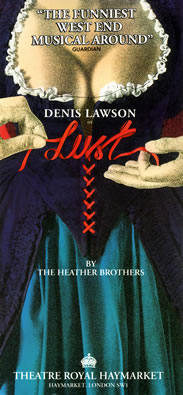
Musical
Original
4) Lust (Original)
Joué durant
Nb de représentations: 128 représentations
Première preview: Inconnu
Première: 19 July 1993
Dernière: Inconnu
Compositeur: Heather Brothers •
Parolier: Heather Brothers •
Libettiste:
Metteur en scène: Bob Carlton •
Chorégraphe: Irvin Davies •
Avec: Denis Lawson (Horner), Paul leonard (Quack), Judith Paris (Lady Fidget), Sophie Aldred (Margery), Julian Curry (Pinchwife), Mark Haddigan, Anthony Dawes, Janet Devenish
Commentaire: Based on “The Country Wife” by William Wycherley, this was described as a “Carry On” comedy set to music. They either loved it, or they hated it. One critic commented: “I’m told that ‘Lust’ was performed to great acclaim at the Queen’s Theatre, Hornchurch; a more telling indictment of Essex Man as a cultural arbiter would be hard to imagine.” It ran for three and a half months. (plus)
Presse:
Plus d'infos sur cette production:
Plus d'infos sur ce musical

Théâtre
Original
3) This Happy Breed (Original)
Joué durant 2 mois
Nb de représentations: 38 représentations
Première preview: 30 April 1943
Première: 30 April 1943
Dernière: 03 July 1943
Compositeur:
Parolier:
Libettiste:
Metteur en scène:
Chorégraphe:
Avec: Noël Coward, Gerald Case, Thatcher, Dennis Price, James Donald, Gwen Floyd, Judy Campbell, Joyce Carey, Jennifer Gray, Molly Johnson, Meg Titheradge, Beryl Measor.
Commentaire:
Presse:
Plus d'infos sur cette production:
Plus d'infos sur ce musical

Théâtre
2) Merchant of Venice (The) ()
Joué durant
Nb de représentations: 1 représentations
Première preview: Inconnu
Première: 23 April 1926
Dernière: 23 April 1926
Compositeur:
Parolier:
Libettiste: William Shakespeare •
Metteur en scène:
Chorégraphe:
Avec: Laurence Olivier ( Gentleman )
Commentaire:
Presse:
Plus d'infos sur cette production:
Plus d'infos sur ce musical



.png)
.png)





